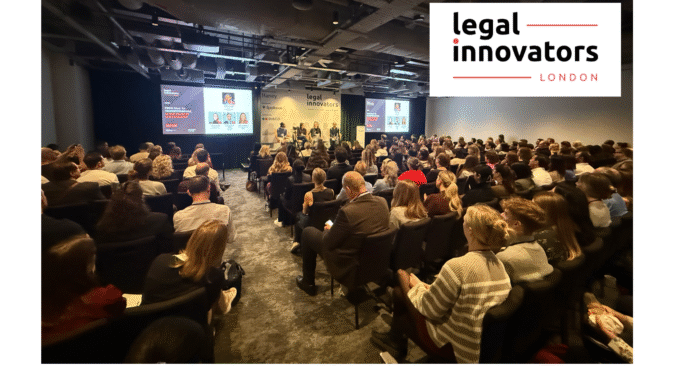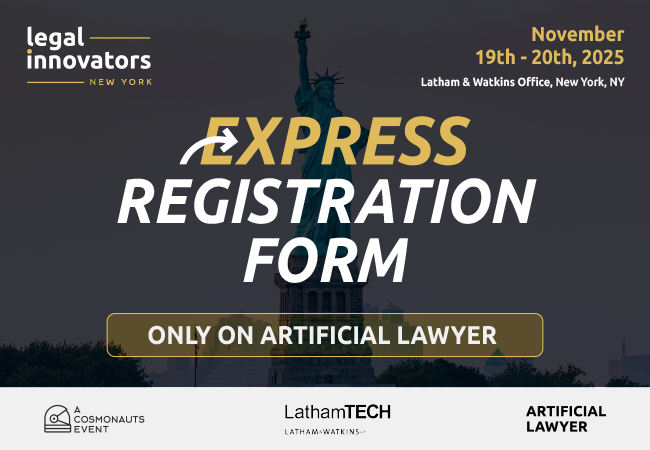
Last week there were plenty of key insights shared by the expert speakers at Legal Innovators UK. Here are some of the ones that caught AL’s attention, with some added comments and interpretations.
Automation and Augmentation – Anton Carniaux, most recently General Counsel at Microsoft in France, helped clear up a central misunderstanding about legal AI. It’s not about whether we should focus on automation, i.e. as much as possible of X workstream should be operated by AI? Or should we focus on a more human-centric augmentation approach, i.e. the work of Y lawyer should be supported and extended with AI? It’s both.
The challenge therefore is not to waste time on internal debates about focusing on one or the other, but developing a twin-track strategy that can drive both approaches simultaneously. This is because some types of tasks really should be automated as much as possible, while clearly others should not. The job of the innovation team in law firms – including those lawyers involved in this work, and of similar teams or individuals working inhouse – is to figure out what the right balance is.
And on this theme, Accenture’s Anand Pandya mentioned the need to ‘industrialise’ some legal workflows. AL applauded this, as back in 2016 when this site launched I changed my LinkedIn profession to ‘Legal Industrialist’, in part as a hat tip to our forefathers in Britain who created the industrial revolution – and in particular where I grew up. Of course, as noted above, not everything can, or should, be industrialised, i.e. automated. The key is deciding which is which.
Innovation, and especially AI adoption, is not one thing, it’s many changes all at once – Kerry Westland at Addleshaw Goddard made several great points in her keynote, but the one that stuck in AL’s mind was the one about how innovation, especially in the context of bringing in AI tools, is not one thing, but a multitude of goals and improvements across the business where positive changes can be made.
I.e. for AL it’s perhaps useful to think of AI-driven innovation as repairing an enormous old mansion, with dozens and dozens of things that need to be updated, as well as the building providing a structure that offers new ‘architectural’ opportunities to improve things. Or, put another way, don’t just buy an AI platform, make sure people are using it, and then say: ‘Job done.’ There’s dozens of jobs to be done!
AI adoption is different depending on one’s legal culture – this was a key point made by a very international panel including Marcelo Moura of Mishcon de Reya, Marisa Monterio Borsboom of ELTA, and Shreya Vajpei, the founder of the Indian LegalTech Network, who is now at Stephenson Harwood. They each gave examples from Brazil, India, and Portugal, about how legal tech and AI projects have taken shape there – and clearly the primary needs and drivers in each market were quite different, and especially different to those seen in the UK and US.
For example, Moura told us about how Brazilian judges have long been using technology – and quite advanced stuff as well – for years, in part because of the way Brazil’s legal system works and tends to create thousands and thousands of new cases. That huge volume pushed Brazilian judges down a path that their English colleagues are still just grappling with.
–
If you liked the sound of Legal Innovators UK, then come along to Legal Innovators New York next week, Nov 19 and 20, in Midtown. It’s free for those at law firms and inhouse. Simply follow the link to Express Registration here.

–
The key takeaway here is: context and culture. Don’t assume that all organisations want to, or will, use legal AI tools the same way, or want the same things. This is especially so for cross-border businesses – and hence most of the large law firms and inhouse teams at global companies.
ROI can’t be measured…oh, yes it can…! There were several speakers who tried to tackle the thorny issue of Return on Investment in AI tools. There was a clear divide here between those who felt that such measurements were impossible to make, especially inside law firms given their time-based business model, (i.e. AI makes things go fast, billable time has an economic structure that ‘wants’ you to be slow), and those who saw ROI data as necessary.
For the ‘no’ camp, the view was that we need to see ROI in more human terms, such as allowing people to have better work/life balance, or to focus on more complex work – but these are very hard to measure objectively.
Another school of thought came more often during the Inhouse Day, and that was if you can’t show ROI then it’s all a waste of time and money. But, if you are in a business that measures things in terms of deal speed, deal volume, and revenue generated by transactions made, then you can show ROI of AI tools much more easily.
This perception gap, and also the structural gap, between law firms and inhouse will be with us for a good while longer.
OK, what else?
- Zach Abramowitz gave a powerful speech about the one-person unicorn, pointing out that with AI today just a very small team can be incredibly productive and create huge value. So, for example consider the hybrid AI law firms such as Crosby and Covenant, both of which have relatively small teams.
- Ben Allgrove at Baker McKenzie gave the room a collective heart attack when talking frankly about the fact that law firms are businesses and so we need to talk about AI and legal tech in relation to the need to drive profits. He commented: ‘I am here for the money!’ I.e. law firms want to make more money, ignoring that in terms of AI adoption is pointless, as that is the reality. QED, AI needs to make law firms more money, or at least sustain their PEP.
- Lucia Elizalde Bulanti at Dechert noted that if lawyers lose their ability to be creative in their work ‘then what is left of a lawyer’? I.e. let’s focus on the positives of AI, which allows lawyers to be more than automated contract reviewers.
- Timo at Cosmonauts told us about his dear and departed fish Bert, how his sister-in-law may have killed him (allegedly), and how he sought help from ChatGPT at this difficult time – which shows just how much we have come to depend on AI now in our lives.
- And finally, Bert Vries at CMS gave a great keynote, and the two key points that have stayed with me are the bear image, and how lawyers learn nearly all they will ever learn about being a lawyer in their first eight years of practice. That time-scale matters, as most new lawyers have already been using AI tools at school…so, how they see the world will be very different.
In terms of the bear, Vries recounted the famous joke about not needing to out-run the bear, but needing to out-run the other people in the forest that the bear is chasing. The bear metaphor was referred to multiple times by other speakers, with different people giving it different meanings, including that the bear was the law firm business model itself, or also that it was the threat of being left behind in terms of legal innovation and AI adoption.
And there were many, many other great insights shared, but you really needed to be there to hear them all….!
So, if you didn’t get a chance to take part this year, we will be holding Legal Innovators UK again next year in November, and if you are in New York already, or would like to make a trip to the Big Apple, then come along to Legal Innovators New York on Nov 19 and 20 for two days of expert insights, networking and the chance to meet some of the leading legal tech companies in the world.
As mentioned, we will be holding Legal Innovators New York next week on Nov 19 and 20.
The event is over two days, Day One: law firms, and Day Two: inhouse – and you are very welcome to take part in both to hear the latest insights about our increasingly AI-driven legal world and network with some of the most innovative law firms, ALSPs, tech companies, and corporates in America and beyond.
If you’d like to take the speedy boarding route to Legal Innovators New York, on Nov 19 and 20, then please sign up here – which is free to attend for those at law firms and inhouse.
See you there!

—
P.S. and as mentioned on Monday, the conference last week was a watershed moment in terms of realising that AL’s founding goal: to see AI transform the legal market, was finally happening for real. You can read more here.
Thanks again to everyone who took part, you were in good company! Over 1,000 people walked through the doors of Legal Innovators UK last week. Great to see so many old friends and also to make some new ones. See you in New York, or perhaps next year in California, Paris, or London again!
Richard Tromans, Founder, Artificial Lawyer and conference creator + chair.
Discover more from Artificial Lawyer
Subscribe to get the latest posts sent to your email.